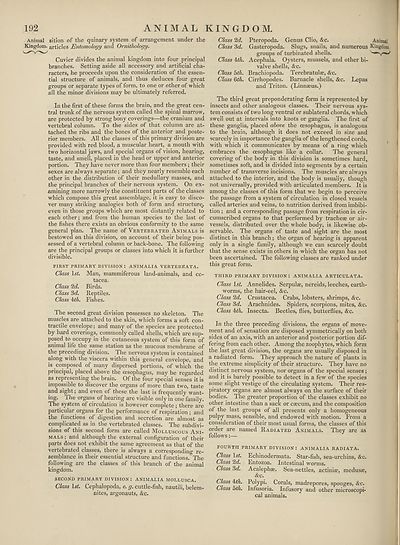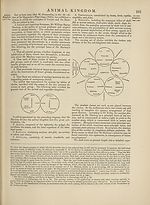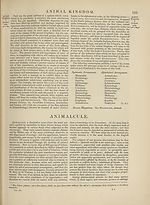Encyclopaedia Britannica > Volume 3, Anatomy-Astronomy
(200) Page 192
Download files
Complete book:
Individual page:
Thumbnail gallery: Grid view | List view

192
ANIMAL KINGDOM.
Animal sition of the quinary system of arrangement under the
Kingdom, articles Entomology and Ornithology.
Cuvier divides the animal kingdom into four principal
branches. Setting aside all accessory and artificial cha¬
racters, he proceeds upon the consideration of the essen¬
tial structure of animals, and thus deduces four great
groups or separate types of form, to one or other of which
all the minor divisions may be ultimately referred.
In the first of these forms the brain, and the great cen¬
tral trunk of the nervous system called the spinal marrow,
are protected by strong bony coverings—the cranium and
vertebral column. To the sides of that column are at¬
tached the ribs and the bones of the anterior and poste¬
rior members. All the classes of this primary division are
provided with red blood, a muscular heart, a mouth with
two horizontal jaws, and special organs of vision, hearing,
taste, and smell, placed in the head or upper and anterior
portion. They have never more than four members; their
sexes are always separate; and they nearly resemble each
other in the distribution of their medullary masses, and
the principal branches of their nervous system. On ex¬
amining more narrowly the constituent parts of the classes
which compose this great assemblage, it is easy to disco¬
ver many striking analogies both of form and structure,
even in those groups which are most distantly related to
each other; and from the human species to the last of
the fishes there exists an obvious conformity to the same
general plan. The name of Veetebrated Animals is
bestowed on this division, on account of their being pos¬
sessed of a vertebral column or back-bone. The following
are the principal groups or classes into which it is further
divisible.
FIRST PRIMARY DIVISION! ANIMALIA. VERTEBRATA.
Class 1st. Man, mammiferous land-animals, and ce¬
tacea.
Class 2d. Birds.
Class 3d. Reptiles.
Class fall. Fishes.
The second great division possesses no skeleton. The
muscles are attached to the skin, which forms a soft con¬
tractile envelope; and many of the species are protected
by hard coverings, commonly called shells, which are sup¬
posed to occupy in the cutaneous system of this form of
animal life the same station as the mucous membrane of
the preceding division. The nervous system is contained
along with the viscera within this general envelope, and
is composed of many dispersed portions, of which the
principal, placed above the oesophagus, may be regarded
as representing the brain. Of the four special senses it is
impossible to discover the organs of more than two, taste
and sight; and even of these the last is frequently want¬
ing. The organs of hearing are visible only in one family.
The system of circulation is however complete; there are
particular organs for the performance of respiration ; and
the functions of digestion and secretion are almost as
complicated as in the vertebrated classes. The subdivi¬
sions of this second form are called Molluscous Ani¬
mals ; and although the external configuration of their
parts does not exhibit the same agreement as that of the
vertebrated classes, there is always a corresponding re¬
semblance in their essential structure and functions. The
following are the classes of this branch of the animal
kingdom.
SECOND PRIMARY DIVISION! ANIMALIA MOLLUSCA.
Class 1st. Cephalopoda, e. g. cuttle-fish, nautili, belem-
nites, argonauts, &c.
Class 2d.
Class 3d.
Class \th.
Class 5th.
Class 5th.
Pteropoda. Genus Clio, &c.
Gasteropoda. Slugs, snails, and numerous
groups of turbinated shells.
Acephala. Oysters, mussels, and other bi¬
valve shells, &c.
Brachiopoda. Terebratulae, &c.
Cirrhopodes. Barnacle shells, &c. Lepas
and Triton. (Linnaeus.)
The third great preponderating form is represented by
insects and other analogous classes. Their nervous sys¬
tem consists of two long ventral or sublateral chords, which
swell out at intervals into knots or ganglia. The first of
these ganglia, placed above the oesophagus, is analogous
to the brain, although it does not exceed in size and
scarcely in importance the ganglia of the lengthened cords,
with which it communicates by means of a ring which
embraces the oesophagus like a collar. The general
covering of the body in this division is sometimes hard,
sometimes soft, and is divided into segments by a certain
number of transverse incisions. The muscles are always
attached to the interior, and the body is usually, though
not universally, provided with articulated members. It is
among the classes of this form that we begin to perceive
the passage from a system of circulation in closed vessels
called arteries and veins, to nutrition derived from imbibi¬
tion ; and a corresponding passage from respiration in cir¬
cumscribed organs to that performed by tracheae or air-
vessels, distributed over the whole body, is likewise ob¬
servable. The organs of taste and sight are the most
distinct in this branch; the organ of hearing is apparent
only in a single family, although we can scarcely doubt
that the sense exists in others in which the organ has not
been ascertained. The following classes are ranked under
this great form.
THIRD PRIMARY DIVISION ! ANIMALIA ARTICULATA.
Class 1^. Annelides. Serpulae, nereids, leeches, earth¬
worms, the hair-eel, &c.
Class 2d. Crustacea. Crabs, lobsters, shrimps, &c.
Class 3d. Arachnides. Spiders, scorpions, mites, &c.
Class \:th. Insecta. Beetles, flies, butterflies, &c.
In the three preceding divisions, the organs of move¬
ment and of sensation are disposed symmetrically on both
sides of an axis, with an anterior and posterior portion dif¬
fering from each other. Among the zoophytes, which form
the last great division, the organs are usually disposed in
a radiated form. They approach the nature of plants in
the extreme simplicity of their structure. They have no
distinct nervous system, nor organs of the special senses;
and it is barely possible to detect in a few of the species
some slight vestige of the circulating system. Their res¬
piratory organs are almost always on the surface of their
bodies. The greater proportion of the classes exhibit no
other intestine than a sack or caecum, and the composition
of the last groups of all presents only a homogeneous
pulpy mass, sensible, and endowed with motion. From a
consideration of their most usual forms, the classes of this
order are named Radiated Animals. They are as
follows:—
fourth primary division: ANIMALIA radiata.
Class 1st.
Class 2d.
Class 3d.
Class \th.
Class 5th.
Echinodermata. Star-fish, sea-urchins, &c.
Lntozoa. Intestinal worms.
Acalephae. Sea-nettles, actiniae, medusae,
Sec.
Polypi. Corals, madrepores, sponges, &c.
Infusoria. Infusory and other microscopi*
cal animals.
Animal
ANIMAL KINGDOM.
Animal sition of the quinary system of arrangement under the
Kingdom, articles Entomology and Ornithology.
Cuvier divides the animal kingdom into four principal
branches. Setting aside all accessory and artificial cha¬
racters, he proceeds upon the consideration of the essen¬
tial structure of animals, and thus deduces four great
groups or separate types of form, to one or other of which
all the minor divisions may be ultimately referred.
In the first of these forms the brain, and the great cen¬
tral trunk of the nervous system called the spinal marrow,
are protected by strong bony coverings—the cranium and
vertebral column. To the sides of that column are at¬
tached the ribs and the bones of the anterior and poste¬
rior members. All the classes of this primary division are
provided with red blood, a muscular heart, a mouth with
two horizontal jaws, and special organs of vision, hearing,
taste, and smell, placed in the head or upper and anterior
portion. They have never more than four members; their
sexes are always separate; and they nearly resemble each
other in the distribution of their medullary masses, and
the principal branches of their nervous system. On ex¬
amining more narrowly the constituent parts of the classes
which compose this great assemblage, it is easy to disco¬
ver many striking analogies both of form and structure,
even in those groups which are most distantly related to
each other; and from the human species to the last of
the fishes there exists an obvious conformity to the same
general plan. The name of Veetebrated Animals is
bestowed on this division, on account of their being pos¬
sessed of a vertebral column or back-bone. The following
are the principal groups or classes into which it is further
divisible.
FIRST PRIMARY DIVISION! ANIMALIA. VERTEBRATA.
Class 1st. Man, mammiferous land-animals, and ce¬
tacea.
Class 2d. Birds.
Class 3d. Reptiles.
Class fall. Fishes.
The second great division possesses no skeleton. The
muscles are attached to the skin, which forms a soft con¬
tractile envelope; and many of the species are protected
by hard coverings, commonly called shells, which are sup¬
posed to occupy in the cutaneous system of this form of
animal life the same station as the mucous membrane of
the preceding division. The nervous system is contained
along with the viscera within this general envelope, and
is composed of many dispersed portions, of which the
principal, placed above the oesophagus, may be regarded
as representing the brain. Of the four special senses it is
impossible to discover the organs of more than two, taste
and sight; and even of these the last is frequently want¬
ing. The organs of hearing are visible only in one family.
The system of circulation is however complete; there are
particular organs for the performance of respiration ; and
the functions of digestion and secretion are almost as
complicated as in the vertebrated classes. The subdivi¬
sions of this second form are called Molluscous Ani¬
mals ; and although the external configuration of their
parts does not exhibit the same agreement as that of the
vertebrated classes, there is always a corresponding re¬
semblance in their essential structure and functions. The
following are the classes of this branch of the animal
kingdom.
SECOND PRIMARY DIVISION! ANIMALIA MOLLUSCA.
Class 1st. Cephalopoda, e. g. cuttle-fish, nautili, belem-
nites, argonauts, &c.
Class 2d.
Class 3d.
Class \th.
Class 5th.
Class 5th.
Pteropoda. Genus Clio, &c.
Gasteropoda. Slugs, snails, and numerous
groups of turbinated shells.
Acephala. Oysters, mussels, and other bi¬
valve shells, &c.
Brachiopoda. Terebratulae, &c.
Cirrhopodes. Barnacle shells, &c. Lepas
and Triton. (Linnaeus.)
The third great preponderating form is represented by
insects and other analogous classes. Their nervous sys¬
tem consists of two long ventral or sublateral chords, which
swell out at intervals into knots or ganglia. The first of
these ganglia, placed above the oesophagus, is analogous
to the brain, although it does not exceed in size and
scarcely in importance the ganglia of the lengthened cords,
with which it communicates by means of a ring which
embraces the oesophagus like a collar. The general
covering of the body in this division is sometimes hard,
sometimes soft, and is divided into segments by a certain
number of transverse incisions. The muscles are always
attached to the interior, and the body is usually, though
not universally, provided with articulated members. It is
among the classes of this form that we begin to perceive
the passage from a system of circulation in closed vessels
called arteries and veins, to nutrition derived from imbibi¬
tion ; and a corresponding passage from respiration in cir¬
cumscribed organs to that performed by tracheae or air-
vessels, distributed over the whole body, is likewise ob¬
servable. The organs of taste and sight are the most
distinct in this branch; the organ of hearing is apparent
only in a single family, although we can scarcely doubt
that the sense exists in others in which the organ has not
been ascertained. The following classes are ranked under
this great form.
THIRD PRIMARY DIVISION ! ANIMALIA ARTICULATA.
Class 1^. Annelides. Serpulae, nereids, leeches, earth¬
worms, the hair-eel, &c.
Class 2d. Crustacea. Crabs, lobsters, shrimps, &c.
Class 3d. Arachnides. Spiders, scorpions, mites, &c.
Class \:th. Insecta. Beetles, flies, butterflies, &c.
In the three preceding divisions, the organs of move¬
ment and of sensation are disposed symmetrically on both
sides of an axis, with an anterior and posterior portion dif¬
fering from each other. Among the zoophytes, which form
the last great division, the organs are usually disposed in
a radiated form. They approach the nature of plants in
the extreme simplicity of their structure. They have no
distinct nervous system, nor organs of the special senses;
and it is barely possible to detect in a few of the species
some slight vestige of the circulating system. Their res¬
piratory organs are almost always on the surface of their
bodies. The greater proportion of the classes exhibit no
other intestine than a sack or caecum, and the composition
of the last groups of all presents only a homogeneous
pulpy mass, sensible, and endowed with motion. From a
consideration of their most usual forms, the classes of this
order are named Radiated Animals. They are as
follows:—
fourth primary division: ANIMALIA radiata.
Class 1st.
Class 2d.
Class 3d.
Class \th.
Class 5th.
Echinodermata. Star-fish, sea-urchins, &c.
Lntozoa. Intestinal worms.
Acalephae. Sea-nettles, actiniae, medusae,
Sec.
Polypi. Corals, madrepores, sponges, &c.
Infusoria. Infusory and other microscopi*
cal animals.
Animal
Set display mode to:
![]() Universal Viewer |
Universal Viewer | ![]() Mirador |
Large image | Transcription
Mirador |
Large image | Transcription
Images and transcriptions on this page, including medium image downloads, may be used under the Creative Commons Attribution 4.0 International Licence unless otherwise stated. ![]()
| Encyclopaedia Britannica > Encyclopaedia Britannica > Volume 3, Anatomy-Astronomy > (200) Page 192 |
|---|
| Permanent URL | https://digital.nls.uk/193759948 |
|---|
| Attribution and copyright: |
|
|---|---|
| Shelfmark | EB.16 |
|---|---|
| Description | Ten editions of 'Encyclopaedia Britannica', issued from 1768-1903, in 231 volumes. Originally issued in 100 weekly parts (3 volumes) between 1768 and 1771 by publishers: Colin Macfarquhar and Andrew Bell (Edinburgh); editor: William Smellie: engraver: Andrew Bell. Expanded editions in the 19th century featured more volumes and contributions from leading experts in their fields. Managed and published in Edinburgh up to the 9th edition (25 volumes, from 1875-1889); the 10th edition (1902-1903) re-issued the 9th edition, with 11 supplementary volumes. |
|---|---|
| Additional NLS resources: |
|

